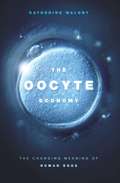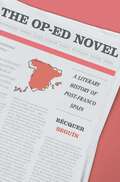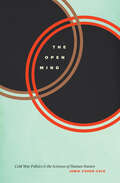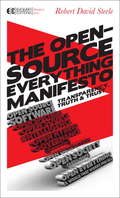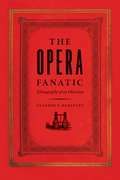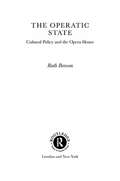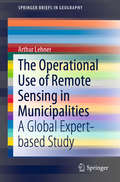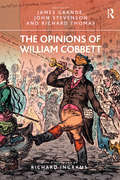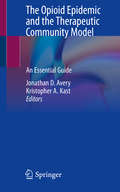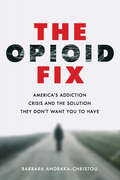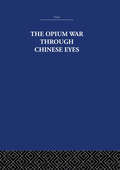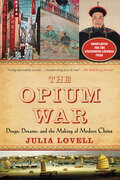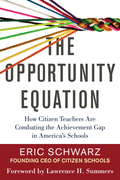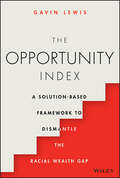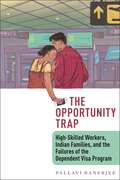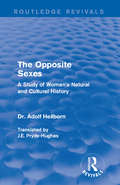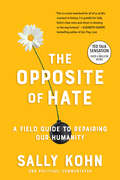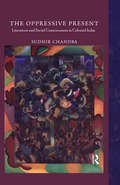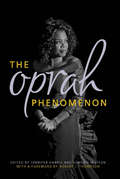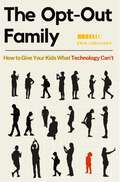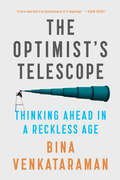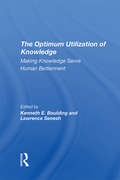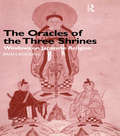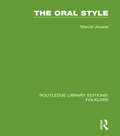- Table View
- List View
The Oocyte Economy: The Changing Meaning of Human Eggs
by Catherine WaldbyIn recent years increasing numbers of women from wealthy countries have turned to egg donation, egg freezing, and in vitro fertilization to become pregnant, especially later in life. This trend has created new ways of using, exchanging, and understanding oocytes—the reproductive cells specific to women. In The Oocyte Economy Catherine Waldby draws on 130 interviews---with scientists, clinicians, and women who have either donated or frozen their oocytes or received those of another woman---to trace how the history of human oocytes' perceived value intersects with the biological and social life of women. Demonstrating how oocytes have come to be understood as discrete and scarce biomedical objects open to valuation, management, and exchange, Waldy examines the global market for oocytes and the power dynamics between recipients and the often younger and poorer donors. With this exploration of the oocyte economy and its contemporary biopolitical significance, Waldby rethinks the relationship between fertility, gendered experience, and biomedical innovation.
The Op-Ed Novel: A Literary History of Post-Franco Spain
by Bécquer Seguín“The Op-Ed Novel not only elegantly recounts a vital intellectual and cultural history of post-Franco Spain. Carefully exploring the careers of Spain’s most eminent writers, it demonstrates, too, the osmotic links between political journalism and literary fiction—salutary reading in the English-speaking countries, where politics and literature are still regarded as strangers to each other.”—Pankaj Mishra, author of Run and HideA new history of contemporary Spanish fiction through the prism of novelists’ newspaper columns.Public intellectuals come in many different stripes, but most of them gain a following at least in part from their writing, whether in the form of magazine articles, newspaper columns, or full-length nonfiction. A few—James Baldwin and Joan Didion are celebrated examples—start out as novelists before turning to the rough-and-tumble of current affairs. In The Op-Ed Novel, Bécquer Seguín undertakes the first book-length study of how contemporary literature is shaped by opinion journalism, focusing on fiction writers who took to the papers in post-Franco Spain and became stewards of their country’s cultural, economic, and political future.Following Spain’s transition to democracy in the late 1970s and early 1980s, internationally acclaimed novelists such as Javier Cercas, Antonio Muñoz Molina, and Javier Marías seized the opportunity to populate the opinion pages of the newly legal free press. The Op-Ed Novel analyzes how the argumentative styles and preoccupations of their columns in El País, Spain’s most widely read daily, bled into their fiction. These and other authors used their novels to settle scores with fellow intellectuals, make speculative historical claims, and advance partisan political projects. At the same time, their literary technique greatly invigorated opinion journalism.A lively guide to the terroir of contemporary Spanish literature, The Op-Ed Novel offers a bird’s-eye view of both the post-Franco intellectual climate and the changing role of the novelist in public life.
The Open Mind: Cold War Politics and the Sciences of Human Nature
by Jamie Cohen-ColeThis study chronicles the rise of psychology as a tool for social analysis during the Cold War Era and the concept of the open mind in American culture. In the years following World War II, a scientific vision of the rational, creative, and autonomous self took hold as an essential way of understanding society. In The Open Mind, science historian Jamie Cohen-Cole demonstrates how this notion of the self became a defining feature of Cold War culture. From 1945 to 1965, policy makers used this new concept of human nature to advance a centrist political agenda and instigate nationwide educational reforms that promoted more open, and indeed more human, minds. The new field of cognitive science was central to this project, helping to overthrow the behaviorist view that the mind either did not exist or could not be studied scientifically. While the concept of the open mind initially unified American culture, this unity started to fracture between 1965 and 1975, as the ties between political centrism and the scientific account of human nature began to unravel. During the late 1960s, feminists and the New Left repurposed psychological tools to redefine open-mindedness as a characteristic of left-wing politics. As a result, once-liberal intellectuals became neoconservative, and in the early 1970s, struggles against open-mindedness gave energy and purpose to the right wing.
The Open World, Hackbacks and Global Justice
by A. Jean ThomasThis book explores the current impasse that global regulators face in the digital sphere. Computer technology has advanced human civilization tenfold, but the freedom to interact with others in cyberspace has made individuals, discrete communities, organizations and governments more vulnerable to abuse. In consequence, political decision-makers are seriously considering granting limited legal immunity to victims who decide to ‘hack- back.’ Many victims frustrated by the slow pace of law enforcement in cyberspace have chosen to ‘take the law into their own hands,’ retaliating against those who have stolen valuable data and damaged network operations. Political deliberations about limited immunity for hackbacks usually ignore global justice and moral justifications for ‘active defense’ policies. Typically, cyber security policies balance deterrence against two different understandings of morality and the ‘good life’ : fairness or welfare. This book proposes a third moral rationale for cyber security policies : capability theory, developed principally by Amartya Sen and Martha Nussbaum. Properly formulated, a capability-based defense of retaliatory hackbacks can minimize attribution and cyber-escalation risks, deter bad behavior by casual computer users, disingenuous security experts, big tech companies, criminals and rogue governments, and satisfy calls for more retributive and distributive justice in the ‘open world’. This book will appeal to legal theorists, political philosophers, social activists, investors, international relations scholars and businesspeople in the tech community.
The Open-Source Everything Manifesto
by Robert David Steele Howard BloomWhat the world lacks right now--especially the United States, where every form of organization from government to banks to labor unions has betrayed the public trust--is integrity. Also lacking is public intelligence in the sense of decision-support: knowing what one needs to know in order to make honest decisions for the good of all, rather than corrupt decisions for the good of the few.The Open-Source Everything Manifesto is a distillation of author, strategist, analyst, and reformer Robert David Steele life's work: the transition from top-down secret command and control to a world of bottom-up, consensual, collective decision-making as a means to solve the major crises facing our world today. The book is intended to be a catalyst for citizen dialog and deliberation, and for inspiring the continued evolution of a nation in which all citizens realize our shared aspiration of direct democracy--informed participatory democracy. Open-Source Everything is a cultural and philosophical concept that is essential to creating a prosperous world at peace, a world that works for one hundred percent of humanity. The future of intelligence is not secret, not federal, and not expensive. It is about transparency, truth, and trust among our local to global collective. Only "open" is scalable. As we strive to recover from the closed world corruption and secrecy that has enabled massive fraud within governments, banks, corporations, and even non-profits and universities, this timely book is a manifesto for liberation--not just open technology, but open everything.From the Trade Paperback edition.sive and whether you agree with him or not, you cannot ignore what he says."
The Opera Fanatic: Ethnography of an Obsession
by Claudio E. BenzecryThough some dismiss opera as old-fashioned, it shows no sign of disappearing from the world’s stage. So why do audiences continue to flock to it? Given its association with wealth, one might imagine that opera tickets function as a status symbol. But while a desire to hobnob with the upper crust might motivate the occasional operagoer, for hardcore fans the real answer, according to The Opera Fanatic, is passion—they do it for love. Opera lovers are an intense lot, Claudio E. Benzecry discovers in his look at the fanatics who haunt the legendary Colón Opera House in Buenos Aires, a key site for opera’s globalization. Listening to the fans and their stories, Benzecry hears of two-hundred-mile trips for performances and nightlong camp-outs for tickets, while others testify to a particular opera’s power to move them—whether to song or to tears—no matter how many times they have seen it before. Drawing on his insightful analysis of these acts of love, Benzecry proposes new ways of thinking about people’s relationship to art and shows how, far from merely enhancing aspects of everyday life, art allows us to transcend it.
The Operatic State: Cultural Policy and the Opera House (Routledge Harwood Studies In Cultural Policy)
by Ruth BeresonThe Operatic State examines the cultural, financial, and political investments that have gone into the maintenance of opera and opera houses in Europe, the USA and Australia. It analyses opera's nearly immutable form throughout wars, revolutions, and vast social changes throughout the world. Bereson argues that by legitimising the power of the state through universally recognised ceremonial ritual, opera enjoys a privileged status across three continents, often to the detriment of popular and indigenous art forms.
The Operational Use of Remote Sensing in Municipalities: A Global Expert-based Study (SpringerBriefs in Geography)
by Arthur LehnerThis book presents the operational use of remote sensing in municipalities for urban planning purposes. Through a unique study among more than 70 cities and institutions in 41 countries, it reveals the remaining gap of knowledge and awareness for remote sensing data, methods, and instruments. It sheds light on the uncertainties and shows what remote sensing data are acquired and by which departments they are used. The tasks and activities remote sensing data are used for, are extensively presented. In the times of open government data, digital citizenship and participation movements, this book provides a comprehensive overview of the topic and intends to raise the awareness for the importance of remote sensing to the society.
The Opinions of William Cobbett
by John Stevenson James GrandePolitician, journalist, reformer, convict, social commentator and all-round thorn in the side of the establishment, William Cobbett cut a swathe through late-eighteenth and early-nineteenth century British society with his copious and acerbic writings on any and every issue that caught his attention. Both a radical and a conservative, and with strong opinions on any given subject, Cobbett had a talent for controversial and pugnacious writing that echoes down the centuries and still rings fresh today. Commemorating the 250th anniversary of Cobbett’s birth in 1763, this book provides a selection of his writings - both published and unpublished - that highlight his talents, obsessions, and concerns. From corruption and Parliamentary reform, poverty and commerce, to patriotism and religion, the selections display Cobbett at his best - sometimes outraged and excoriating, sometimes sympathetic and reasoned - but always honest and witty. Divided into 14 chapters each dealing with a particular theme, the selections are contextualised so as to provide the necessary historical background for any readers who may be unfamiliar with the period. In so doing, the book not only brings to life the dynamic and rumbustious world of Georgian England within which Cobbett moved, but also reveals many uncanny parallels with modern concerns. Whether espousing political reform, promoting rural affairs or decrying a spiralling national debt, many of Cobbett’s opinions seem as relevant today as when they were first written. Certainly modern readers will find much here to educate, amuse and admire.
The Opioid Epidemic and the Therapeutic Community Model: An Essential Guide
by Jonathan D. Avery Kristopher A. KastThis book aims to explore the evidence supporting the therapeutic community (TC) modality as a uniquely effective approach to care of individuals living with opioid use disorder and other addictions, and also to identify salient mediators of improved outcome, including long-term treatment and removal from the opioid-associated environment. The book includes multiple international perspectives and is designed for worldwide appeal—for countries that have established some TCs with success, those looking to improve care, and those looking to build them for the first time. Written by experts in addiction psychiatry and medicine, this book describes the unique role of therapeutic communities in treating substance use disorders, how the model has changed over time and adapted to diverse sociocultural contexts and systems of care, and how the TC model may serve an important population in the context of the current opioid epidemic. The chapters are written so as to be accessible for clinicians across specialties and professions. The Opioid Epidemic and the Therapeutic Community Model is an excellent resource for all professionals interested in diverse and effective models of care to treat opioid use disorder and other addictions, including addiction medicine specialists, psychiatrists, psychologists, rehabilitation administrators, hospitalists, social workers, public health workers, students, and the interested public
The Opioid Fix: America's Addiction Crisis and the Solution They Don't Want You to Have
by Barbara Andraka-ChristouWhy medication-assisted treatment, the most effective tool for battling opioid addiction, is significantly underused in the United States.Bronze Winner of the 2021 IPPY Book Award in Health/Medicine/Nutrition, Gold Winner of the 2020 Foreword INDIES Award in HealthAmerica's addiction crisis is growing worse. More than 115 Americans die daily from opioid overdoses, with half a million deaths expected in the next decade. Time and again, scientific studies show that medications like Suboxone and methadone are the most reliable and effective treatment, yet more than 60 percent of US addiction treatment centers fail to provide access to them. In The Opioid Fix, Barbara Andraka-Christou highlights both the promise and the underuse of medication-assisted treatment (MAT). Addiction, Andraka-Christou writes, is a chronic medical condition. Why treat it, then, outside of mainstream medicine? Drawing on more than 100 in-depth interviews with people in recovery, their family members, treatment providers, and policy makers, Andraka-Christou reveals a troubling landscape characterized by underregulated treatment centers and unnecessary ideological battles between twelve-step support groups and medication providers. The resistance to MAT—from physicians who won't prescribe it, to drug courts that prohibit it, to politicians who overregulate it—showcases the narrow-mindedness of the system and why it isn't working. Recounting the true stories of people in recovery, this groundbreaking book argues that MAT needs to be available to anyone suffering from opioid addiction. Unlike other books about the opioid crisis, which have largely focused on causal factors like pharmaceutical overprescription and heroin trafficking, this book focuses on people who have already developed an opioid addiction but are struggling to find effective treatment. Validating the experience of hundreds of thousands of Americans, The Opioid Fix sounds a loud call for policy reforms that will help put lifesaving drugs into the hands of those who need them the most.
The Opium War Through Chinese Eyes
by Arthur Waley The Arthur EstateFirst published in 1958. This volume translates and places in the appropriate historical context a number of private documents, such as diaries, autobiographies and confessions, which explain what the Opium War felt like on the Chinese side.
The Opium War: Drugs, Dreams, and the Making of Modern China
by Julia LovellThis &“crisp and readable account&” of the nineteenth century British campaign sheds light on modern Chinese identity through &“a heartbreaking story of war&” (The Wall Street Journal). In October 1839, a Windsor cabinet meeting voted to begin the first Opium War against China. Bureaucratic fumbling, military missteps, and a healthy dose of political opportunism and collaboration followed. Rich in tragicomedy, The Opium War explores the disastrous British foreign-relations move that became a founding myth of modern Chinese nationalism, and depicts China&’s heroic struggle against Western conspiracy. Julia Lovell examines the causes and consequences of the Opium War, interweaving tales of the opium pushers and dissidents. More importantly, she analyses how the Opium Wars shaped China&’s self-image and created an enduring model for its interactions with the West, plagued by delusion and prejudice.
The Opportunity Equation
by Eric Schwarz Lawrence H. SummersSchwarz, founder of the groundbreaking Citizen Schools program, shares his vision for reducing inequality by pairing successful adults with low-income students. Parental wealth now predicts adult success more than at any point in the last hundred years. And yet as debates about education rage on, and wealth-based achievement gaps grow, too many people fix the blame on one of two convenient scapegoats: poverty or our public schools. But in fact, low-income kids are learning more now than ever before. The real culprit for rising inequality, Eric Schwarz argues in The Opportunity Equation, is that wealthier kids are learning much, much more--mostly outside of school. In summer camps, robotics competitions, sessions with private tutors, and conversations around the dinner table, children from more affluent families build the skills and social networks that propel them to success. In The Opportunity Equation, Schwarz tells the story of how he founded the pioneering Citizen Schools program to combat rising inequality by bringing these same opportunities to children who don't have access to them. By increasing learning time in schools and harnessing the power of an army of volunteers with various skills and professional backgrounds--lawyers, engineers, carpenters, journalists, nonprofit leaders, and grandmothers who sew--Citizen Schools offers after-school apprenticeships that provide the building blocks for adult success. Recounting the triumphs and setbacks he's encountered in implementing the program, Schwarz shows that some of the nation's lowest-performing schools in its lowest-income cities can, with help, provide their students with many of the same experiences wealthy communities afford to their children. The results have been proven: in the dozen school districts, from New York to Oakland, that have partnered with Citizen Schools, rates of attendance, proficiency, graduation, and college acceptance have gone up--and the achievement gap closes. At a time when many stakeholders in the education debates are looking for new, silver-bullet shortcuts to educational excellence, Schwarz shows that the best solution is human-centered, rooted in the American tradition of citizen voluntarism, and, most important, achievable. We can provide quality education for all students and close the opportunity gap in this country--and we can do it together.
The Opportunity Index: A Solution-Based Framework to Dismantle the Racial Wealth Gap
by Gavin LewisA bold and fresh perspective unravelling the economics of racial inequality In The Opportunity Index, BlackRock Managing Director and co-founder of the #Talkaboutblack movement, Gavin Lewis, skillfully plots the origins of the racial wealth gap and its impact on the inequalities faced by the Black community today. Weaving a personal and at times moving narrative through some of the most disruptive events of our time, he offers a blueprint for businesses and individuals to understand the risks and opportunities presented by inequality and issues an urgent call to action. The Opportunity Index also presents: A root cause-oriented and solutions-focused exploration of the racial wealth gap and its role in social, health, and opportunity inequality A perspective that moves beyond the typical workplace discussion to explore the deeper truths about society and the role of capitalism The lessons learned from the #BlackLivesMatter, #MeToo, and climate change movements and how these provide case studies for real and lasting changeAn eye-opening and insightful treatment of what equity and access mean in the context of international finance, The Opportunity Index will earn a place in the libraries of finance professionals, business leaders, teachers, academics, community leaders, diversity, equity, and inclusion experts, and anyone else with an interest in racial, social, and economic fairness around the world.
The Opportunity Trap: High-Skilled Workers, Indian Families, and the Failures of the Dependent Visa Program
by Pallavi BanerjeeWinner, 2024 Global Sociology Book Award, given by the Canadian Sociological Association Winner of the 2024 Silver Medal for the Canada West Non-Fiction category, given by The Independent Publisher Book AwardWinner of the ASA Section on Asia and Asian America's Book Award on Asian AmericaHonorable Mention, 2024 Social Science Category Book Awards, given by the Association for Asian American StudiesHonorable Mention, 2022 Betty and McClung Lee Book Award, given by the Association for Humanist SociologyUnravels how US visa laws fail Indian professional workers and their legally dependent spouses and familiesThe Opportunity Trap is the first book to look at the impact of the H-4 dependent visa programs on women and men visa holders in Indian families in America. Comparing two distinct groups of Indian immigrant families —families of male high-tech workers and female nurses—Pallavi Banerjee reveals how visa policies that are legally gender and race neutral in fact have gendered and racialized ramifications for visa holders and their spouses. Drawing on interviews with fifty-five Indian couples, Banerjee highlights the experiences of high-skilled immigrants as they struggle to cope with visa laws, which forbid their spouses from working paid jobs. She examines how these unfair restrictions destabilize—if not completely dismantle—families, who often break under this marital, financial, and emotional stress. Banerjee shows us, through the eyes of immigrants themselves, how the visa process strips them of their rights, forcing them to depend on their spouses and the government in fundamentally challenging ways. The Opportunity Trap provides a critical look at our visa system, underscoring how it fails immigrant families.
The Opposite Sexes: A Study of Woman's Natural and Cultural History (Routledge Revivals)
by Dr. Adolf HeilbornOriginally published in English in 1927, this study discusses the physical differences between men and women and how this affected the views of men and women of society. With all known information at the time, the author also details perceived mental differences between the sexes and finishes with a brief cultural history of women’s place in society. This title will be of interest to students of Gender Studies and History.
The Opposite of Hate: A Field Guide to Repairing Our Humanity
by Sally Kohn“A stunning debut by a truly gifted writer—an eye-opening read for both liberals and conservatives—and it could not come at a better time.”—Adam Grant, New York Times bestselling author of Option B, with Sheryl Sandberg What is the opposite of hate? As a progressive commentator on Fox News and now CNN, Sally Kohn has made a career out of bridging intractable political differences and learning how to talk respectfully with people whose views she disagrees with passionately. Her viral TED Talk on the need to practice emotional—rather than political—correctness sparked a new way of considering how often we amplify our differences and diminish our connections. But these days even famously “nice” Kohn finds herself wanting to breathe fire at her enemies. It was time, she decided, to look into the epidemic of hate all around us and learn how we can stop it. In The Opposite of Hate, Kohn talks to leading scientists and researchers and investigates the evolutionary and cultural roots of hate and how incivility can be a gateway to much worse. She travels to Rwanda, the Middle East, and across the United States, introducing us to former terrorists and white supremacists, and even some of her own Twitter trolls, drawing surprising lessons from dramatic and inspiring stories of those who left hate behind. As Kohn confronts her own shameful moments, whether it was back when she bullied a classmate or today when she harbors deep partisan resentment, she discovers, “The opposite of hate is the beautiful and powerful reality of how we are all fundamentally linked and equal as human beings. The opposite of hate is connection.” Sally Kohn’s engaging, fascinating, and often funny book will open your eyes and your heart.
The Oppressive Present: Literature and Social Consciousness in Colonial India
by Sudhir ChandraMarking a departure from studies on history and literature in colonial India, The Oppressive Present explores the emergence of social consciousness as a result of and in response to the colonial mediation in the late nineteenth century. In focusing on contemporary literature in Hindi, Bengali, Gujarati, and Marathi, it charts an epochal change in the gradual loss of the old pre-colonial self and the configuration of a new, colonized self. It reveals that the ‘oppressive present’ of generations of subjugated Indians remains so for their freed descendants: the consciousness of those colonized generations continues to characterize the ‘modern educated Indian’. The book proposes ambivalence rather than binary categories — such as communalism and nationalism, communalism and secularism, modernity and tradition — as key to understanding the making of this consciousness. This cross-disciplinary volume will prove essential to scholars and students of modern and contemporary Indian history and society, comparative literature and post-colonial studies.
The Oprah Phenomenon
by Jennifer Harris and Elwood Watson&“Excellent essays&” on a business empire, a cultural phenomenon, and the nature of the extraordinary bond between Oprah Winfrey and her fans (Journal of Social History). Oprah Winfrey has built an empire on her ability to connect with and inspire her audience. No longer just a name, &“Oprah&” has become a brand representing a unique style of self-actualizing individualism. The cultural and economic power wielded by Winfrey merits critical evaluation. The contributors to The Oprah Phenomenon examine the origins of her public image and its substantial influence on politics, entertainment, and popular opinion. Contributors address praise from her supporters and weigh criticisms from her detractors. Winfrey&’s ability to create a feeling of intimacy with her audience has long been cited as a foundation of her popularity. She has made headlines by engaging and informing her audience with respect to her personal relationships to race, gender, feminism, and New Age culture. The Oprah Phenomenon explores these relationships in detail. At the root of Winfrey&’s message is her assertion that anyone can be a success regardless of background or upbringing. The contributors scrutinize this message: What does this success entail? Is the motivation behind self-actualization, in fact, merely the hope of replicating Winfrey&’s purchasing power? Is it just a prescription to buy the products she recommends and heed the advice of people she admires, or is it a lifestyle change of meaningful spiritual benefit? The Oprah Phenomenon asks these and many other difficult questions to promote a greater understanding of Winfrey&’s influence on the American consciousness. &“Identifies the common threads that run through Oprah&’s empire, the demographics of her audience, how she brings together women of diverse backgrounds, and her use of empathy and encouragement to foster self-improvement.&” ―Library Journal With a foreword by Robert J. Thompson
The Opt-Out Family: How to Give Your Kids What Technology Can't
by Erin LoechnerDiscover a new and hopeful path forward as you consider your family's approach to social media, screen time, and technology.We've all heard the mind-boggling statistics about technology and social media use. The numbers don't lie; our obsession with smartphones and social media is slowly eroding the very essence of our homes and families. We see it. We feel it. We know it.So what do we do about it?Spoiler alert: Forget parental control apps, time limits, or reward charts. This revolutionary path takes us into the heart of the beast itself: the social media algorithm. Former social media influencer and trailblazer Erin Loechner has seen the perks and pitfalls of social media usage, and she knows how to hack the strategies of tech wizards and platform experts so you can borrow their billion-dollar playbook to engage your family in meaningful ways away from screens.The Opt-Out Family is packed with eye-opening research and startling insights, as well as practical encouragement and creative ideas to transform your family's relationship with today's ever-evolving technology. As a result, you will:Experience more quality time with your children that doesn't revolve around screensCreate healthy habits as a family that will set your children up for success in the futureDiscover what your kids actually need from you, and learn how to delight and engage them better than a device canAnd, ultimately, establish true and lasting influence within your own four walls--and far beyondThe Opt-Out Family unlocks a world where genuine connections flourish and technology takes a backseat. It's time to reclaim your home and build a tech-free family culture that's stronger than your Wi-Fi signal.
The Optimist's Telescope: Thinking Ahead in a Reckless Age
by Bina VenkataramanA trailblazing exploration of how we can plan better for the future: our own, our families’, and our society’s. Instant gratification is the norm today—in our lives, our culture, our economy, and our politics. Many of us have forgotten (if we ever learned) how to make smart decisions for the long run. Whether it comes to our finances, our health, our communities, or our planet, it’s easy to avoid thinking ahead.The consequences of this immediacy are stark: Superbugs spawned by the overuse of antibiotics endanger our health. Companies that fail to invest stagnate and fall behind. Hurricanes and wildfires turn deadly for communities that could have taken more precaution. Today more than ever, all of us need to know how we can make better long-term decisions in our lives, businesses, and society. Bina Venkataraman sees the way forward. A former journalist and adviser in the Obama administration, she helped communities and businesses prepare for climate change, and she learned firsthand why people don’t think ahead—and what can be done to change that. In The Optimist’s Telescope, she draws from stories she has reported around the world and new research in biology, psychology, and economics to explain how we can make decisions that benefit us over time. With examples from ancient Pompeii to modern-day Fukushima, she dispels the myth that human nature is impossibly reckless and highlights the surprising practices each of us can adopt in our own lives—and the ones we must fight for as a society. The result is a book brimming with the ideas and insights all of us need in order to forge a better future.
The Optimum Utilization Of Knowledge: Making Knowledge Serve Human Betterment
by Kenneth E. Boulding Lawrence SeneshWe all have more knowledge than we use; even so, say the editors of this book, ignorance often governs our actions. Society continues to find ways to misuse knowledge–from manipulating information to gain political power to restricting what ideas are explored on university campuses. Thus, when some of the best minds in the country met to focus on the optimum utilization of knowledge, it was not an idle academic inquiry. In these proceedings from that conference, which was sponsored by the Academy of Independent Scholars, the contributors examine several of the key aspects of learning: the importance of knowledge in decision making, the role of our educational system and other systems in producing and disseminating knowledge, and the relationship between knowledge and the physiological, psychological, and cultural bases of the learning process. The misuse of knowledge–or the overuse of ignorance–the authors note, could threaten the existence of the entire planet, if the kind of thinking exemplified by the nuclear arms race prevails.
The Oracles of the Three Shrines: Windows on Japanese Religion
by Brian BockingThis is a richly-illustrated study of 'The Oracles of the Three Shrines', the name given to a hanging scroll depicting three important Japanese shrine-deities and their respective oracle texts. The scroll has evolved continuously in Japan for 600 years, so different examples of it offer a series of 'windows' on developments in Japanese religious belief and practice.
The Oral Style: The Galilean Oral-style Tradition And Its Traditionists (Routledge Library Editions: Folklore)
by Marcel JousseIn this book, first published in 1990, Edgard Sienaert and Richard Whitaker offer the first English translation of Marcel Jousse’s crucially important work, Le style oral. As the translators observe, this study fired the imagination of contemporary intellectuals in Paris soon after its publication and influenced the work of many. In this book, Jousse provides a thorough and detailed theoretical account of the compositional style of oral, as opposed to literate, authors, showing that the antithetical, balancing, formulaic quality of that style is deeply rooted in the psychological and even physiological nature of mankind.
